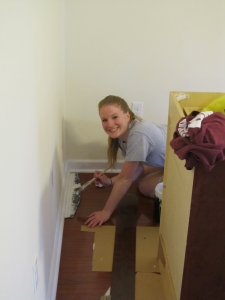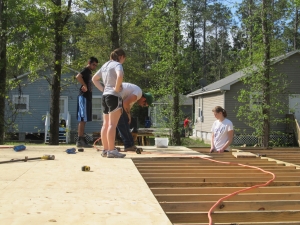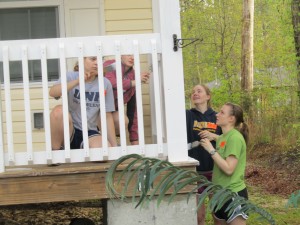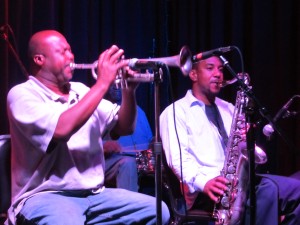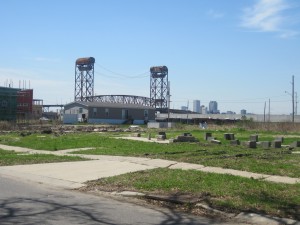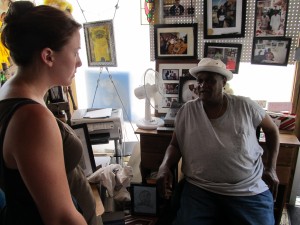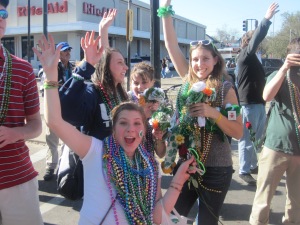Behind the Paneling Sunday, Mar 3 2013
Photo of the Week Chalmette, FEMA, Habitat for Humanity 2:06 pm
The New Orleans Course Tuesday, Jan 22 2013
Uncategorized Habitat for Humanity, Hurricane Katrina, Lower Ninth Ward, Operation Helping Hands, UNH students, UNH-Alternative Break Challenge 10:56 pm
Today marks the beginning of the seventh spring I have taught the New Orleans class. I’m having some difficulty with that realization, which may be because the course helps me mark the passage of time – there’s Christmas, then New Year’s Day, then New Orleans. Moreover, six classes of students and hard-working volunteers have become friends, graduates and colleagues.
Because I have a short attention span, the class evolves from year to year. The bones, the basic structure for the course remain the same, but from year to year there are changes in assignments, readings, and volunteer opportunities. The class dynamic likewise changes. And, as Hurricane Katrina grows smaller in the rear view mirror, New Orleans and the way we approach the storm have been witness to substantial changes, as well.
My first volunteer trip to New Orleans was in March 2006, a little over seven months following Katrina. I worked with some 1300 volunteers out of a FEMA camp in Chalmette, LA. We were fenced in. We had armed guards. Lights out at 10:00pm. A Dollar Store was the only retail establishment open in all of St. Bernard Parish. We were surrounded by thousands of homes, virtually all unoccupied, most still damp from flood waters, and many permanently soiled by oil and petrochemicals. Trees and shrubs could not shake-off being submerged under brackish water for weeks and failed to emerge that spring. And one had to strain to hear a song bird or witness life of any sort.
We worked in teams of 10 to 12, gutting homes in and around Chalmette. Collapsed ceilings and insulation, moldy walls, fetid refrigerators and freezers, and the waterlogged belongings of once proud homeowners were removed, and houses stripped to the studs. With masks, gloves, and goggles we worked in the filth and humidity, revering breaks during the day and racing to the showers and laundry in the afternoon. The homeowners, who cared, came and cried. We piled what porcelain, photographs, or other belongs that could be salvaged in a pile for them to reclaim. It was the worst and hardest job I have ever loved.
To escape the confinement and crowds of the camp, I discovered the Chalmette National Cemetery and Chalmette Battlefield a short walk away. They, like everything else, were damaged by the federal flood and closed, but there was nothing to stop me from visiting. I walked through the graves of generations of soldiers, many of them African-American soldiers from the Civil War. I sat among brick walls crumpled by the flood. I stood behind the redoubt where Andrew Jackson led a rag-tag army of frontiersman, local militia, free blacks, pirates, and Native Americans into battle on January 8, 1815. On the plain that lay between me and our camp, that force defeated the British army that had months prior forced Napoleon into exile. It was there, nearly two centuries later, of course, that the New Orleans course was conceived.
On a couple of evenings I hitched rides into the City where I discovered Frenchmen Street, a musical antidote to the commercialized sleaze of Bourbon Street. Even as the City struggled to recover from the storm, traditional music was rising above the devastation. On Mondays, red beans still boiled on the stove. Café du Monde had a banner proclaiming “Beignets are Back.” And as I sat on a bench on the battlefield and revisited the week in my mind, I thought: how do I share this profound experience, this new found realization with others?
I got back to Durham. I read everything I could find. I listened to musicians and genres that were foreign to me. Together with the rawness of my experience, the New Orleans class was born. A year later, in the spring of 2007, the inaugural class had to suffer through my attempts to share everything that I had learned using dense and wordy PowerPoint slides and drawn-out lectures. It was an act of love for me, but the mode of delivery must have been frustrating to them. At the same time, I worked with UNH-Alternative Break Challenge to organize several trips to work with Habitat for Humanity in New Orleans over spring break. I invited my students to apply and join us.
Five of my students did just that and joined me with UNH-ABC; two others went to New Orleans separately during spring break. We stayed in Violet, LA and worked in the Upper Ninth Ward in and around what would become Musicians’ Village. I watched them work hard during the day. They met and talked to residents. They tapped their toes to music, they caught beads at parades, and they ate Creole food. They combined what we had learned in class with experience. It stuck. It had meaning. And they gained knowledge and understanding in a way that the other students in the class could not. A year later, I asked if the trip could become part of the class, half expecting for the answer to be no. But, I was pleasantly surprised; the trip has been a central part of the class ever since.
Now, the trip defines the class. Before the trip, I give them informational markers to provide reference for them once they get there. And while none of us have attained the fluency of a native, students have just enough history, culture, music, and language to be able to communicate. And boy, do they communicate. They talk to folks in the neighborhoods, the former gang member who recounts mayhem, as well as the great-grandmother who in late 2005 returned to a home in a neighborhood without power; to a City without an operating grocery store. They talk to the musicians about their craft, the waitress about her late, unfortunate incarceration, and they bring all of those conversations back to class. They process. They try to make sense of those threads and combine them with what they read in books and see in film. They make their own judgments. And ultimately, they learn.
And I get to watch the whole thing unfold; and learn with them.
The REAL Spirit of New Orleans Monday, Apr 2 2012
Student Viewpoints Gabrielle I. Chesney, Habitat for Humanity, House of Dance & Feathers, Hurricane Katrina, Lower Ninth Ward, Mardi Gras Indians, New Orleans culture, Ronald W. Lewis, UNH students 1:50 pm
Looking back to the weeks before my first trip to New Orleans, I remember being nervous and wondering what to expect from a city known for its indescribable culture. After spending one day in the city, I was hooked. Our first day experiencing New Orleans as a class helped me to understand the spirit and culture of the city that Bill had been trying to describe to us for the first half of the semester.
Once everybody had settled into the museum, Ronald shared some of his experiences with Hurricane Katrina. While I had heard a lot about Katrina before visiting New Orleans, I didn’t truly understand how it affected the city and her people until hearing Ronald talk about his experiences. He helped me to understand the depth at which the people of the city were affected. One thing he said really stuck with me. When asked about the response to Katrina and the progress that has been made over the past few years he said, “It not the hot story, but it’s an ongoing story”. This was a really great thing to hear right before we started our work with Habitat for Humanity. Living in a world filled with daily disasters and news stories, it is hard to remember that the problems that occur from these events persist long after the hype goes down and volunteering is not longer the popular thing to do. This concept resonated with me and was something I carried with me as I volunteered and hope to remember now that I am back home and far away from the damage of Katrina and the people of New Orleans. So often people jump on the bandwagon to support issues but forget about them shortly afterwards. It makes sense, but it is a shame.
Those are the stories that made the week we spent amazing. Without the people, New Orleans would just be a picturesque city by the water. Once you add these eclectic and passionate people, you have a place that is impossible to forget and sure to change you in one way or another.
Spring Break in New Orleans Monday, Jan 16 2012
Uncategorized Habitat for Humanity, Operation Helping Hands, UNH students, UNH-Alternative Break Challenge 10:56 pm
The title of this post might suggest youthful drinking and exposing body parts for beads, but since Katrina, thousands of college students have gone to New Orleans during spring break to help rebuild a broken city. While much of the country wonders why the job is not finished, anyone who has been out in the neighborhoods in New Orleans knows the extent of the damage wrought by the flood. And that doesn’t even address the fact that New Orleans was in need of quality, affordable long before anyone had equated the name Katrina with a devastating storm.
Since March 2006, a few months after the waters receded, I have worked with dozens of young people who have selflessly given their break from school to help others. They have gutted homes, cleared brush, landscaped, framed walls, spackled, scraped, caulked, primed and painted. And in the process of helping Gulf residents, they have learned about others far different from them…and I suspect they have learned a good deal about themselves.
Since March 2007, I have had the pleasure or working side-by-side with students from the University of New Hampshire. And from that year forward, students in my New Orleans course have been there; initially only a handful, but since 2008 almost every student in the class has made the trip. We have worked in St. Bernard Parish, Waveland, Mississippi, and in neighborhoods throughout New Orleans (Upper Ninth, Faubourg Marigny, Treme, Gentilly, and Carrollton). However, this year is going to be a little different.
We have very happily worked with Operation Helping Hands, a program of Catholic Charities of the Archdiocese of New Orleans for the past three years. Alas, they have phased out their volunteer program. So this year, the students in the the New Orleans course, in conjunction with the UNH-Alternative Break
Challenge, will be moving across Lake Pontchartrain to work with Habitat for Humanity. Mind you, we will be a presence in New Orleans, but during the day we will be working with two different Habitat for Humanity agencies in St. Tammany Parish. Our work will be centered around Slidell and Mandeville, Louisiana. And we’ll be staying at the Peace Mission Center in Slidell. By the way, the volunteer accommodations and meals come highly recommended.
So on this day, as we celebrate a life of Martin Luther King, Jr., who spent his short time with us peacefully advocating on behalf of others, I look forward to working with another group of students who will generously give their time and creature comforts to move his dream forward.
Operation Helping Hands Monday, Mar 1 2010
Uncategorized Habitat for Humanity, Katrina Relief, Operation Helping Hands, UNH students 4:22 am
 Since 2006, I have worked with three different relief operations along the Gulf Coast. Habitat for Humanity needs no introduction. They are the gold standard for building affordable housing for those in need. In 2006, in the wake of the storm, they focused on gutting homes (left). A year later, I joined UNH students working with Habitat on constructing new homes in the Upper Ninth Ward, in and around the Musicians’ Village. In 2008, my students and I worked with Katrina Relief, a small agency operating in and around Waveland, Mississippi. They are a jack-of all-trades organization that contributes much-needed manpower to a hard-hit, yet out of the way section of coastal Mississippi. Then last year, we moved back into New Orleans to work with Operation Helping Hands.
Since 2006, I have worked with three different relief operations along the Gulf Coast. Habitat for Humanity needs no introduction. They are the gold standard for building affordable housing for those in need. In 2006, in the wake of the storm, they focused on gutting homes (left). A year later, I joined UNH students working with Habitat on constructing new homes in the Upper Ninth Ward, in and around the Musicians’ Village. In 2008, my students and I worked with Katrina Relief, a small agency operating in and around Waveland, Mississippi. They are a jack-of all-trades organization that contributes much-needed manpower to a hard-hit, yet out of the way section of coastal Mississippi. Then last year, we moved back into New Orleans to work with Operation Helping Hands.
 Operation Helping Hands coordinates volunteers for the Archdiocese of New Orleans. They did not exist prior to Katrina, but in the aftermath of the tempest, the Archdiocese fielded thousands of call from people who wanted to serve on behalf of the people of New Orleans. And from the time the waters began to recede from the city, Operation Helping Hands has hosted over 22,500 volunteers. And those volunteers have put in nearly two-thirds of a million volunteer hours. In the process, these volunteers have gutted nearly 2,000 homes. They have built 140 homes with 21 underway. And they have painted 295 additional homes. And my students were an active and involved part of that.
Operation Helping Hands coordinates volunteers for the Archdiocese of New Orleans. They did not exist prior to Katrina, but in the aftermath of the tempest, the Archdiocese fielded thousands of call from people who wanted to serve on behalf of the people of New Orleans. And from the time the waters began to recede from the city, Operation Helping Hands has hosted over 22,500 volunteers. And those volunteers have put in nearly two-thirds of a million volunteer hours. In the process, these volunteers have gutted nearly 2,000 homes. They have built 140 homes with 21 underway. And they have painted 295 additional homes. And my students were an active and involved part of that.
Our experience with Operation Helping Hands was a gift. The food was OK, the housing over in Jefferson Parish was adequate, but the work experience was exquisite. The team leaders were young, energetic and accessible to student volunteers. The work was meaningful and tied to New Orleans neighborhoods. Students came away, not only with a sense of accomplishment, but with the realization that they could exhibit the same level of selflessness as the OHH leaders once they graduate from college.
 That is: it was a great introduction to New Orleans; a fine example of service learning; and a tangible model of what direction one may take after graduation. To me, that was the gift to us of working with Operation Helping Hands.
That is: it was a great introduction to New Orleans; a fine example of service learning; and a tangible model of what direction one may take after graduation. To me, that was the gift to us of working with Operation Helping Hands.













